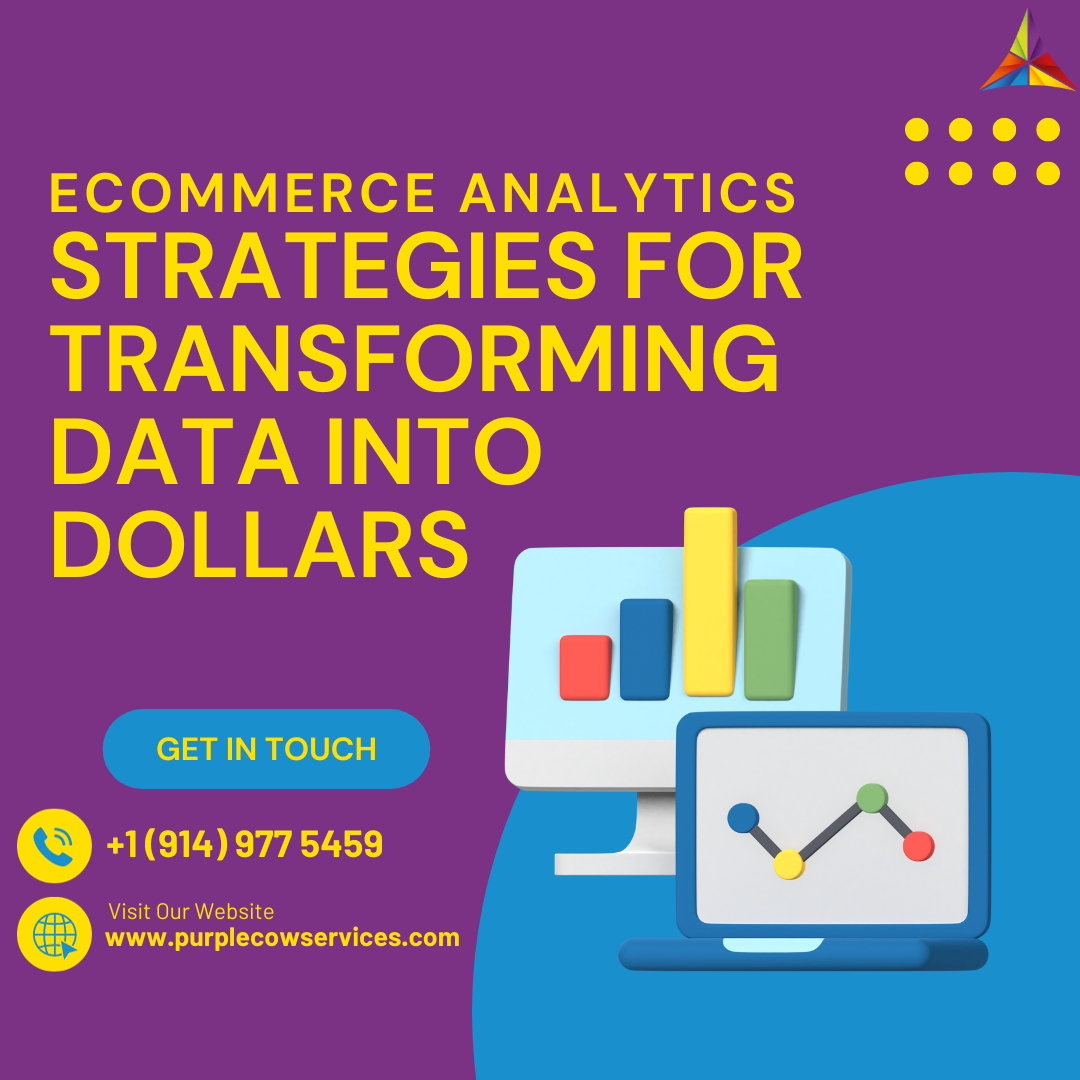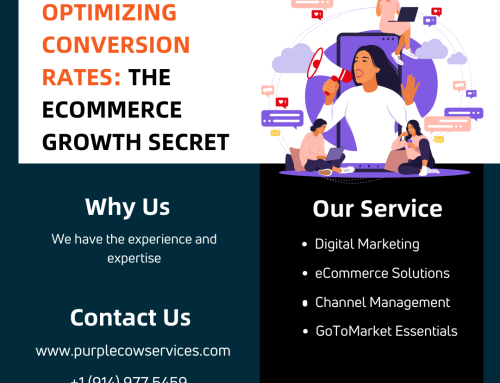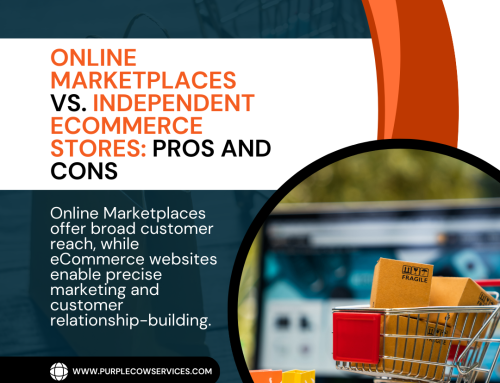In today's dynamic eCommerce landscape, achieving success requires more than just a digital storefront. It's about deciphering the intricate language of customer behavior, optimizing product offerings, and making decisions that translate data into dollars.
Share This Story, Choose Your Platform!
eCommerce analytics stands at the forefront of this transformation, serving as a compass that guides businesses toward higher revenue and sustained growth.
Understanding eCommerce Analytics
Defining eCommerce Analytics
eCommerce analytics serves as the eyes and ears of your online business. It is the systematic process of gathering, analyzing, and translating data into actionable insights. From website traffic patterns to customer purchase behaviors, it encompasses a broad spectrum of metrics that unveil the hidden facets of your eCommerce operations.
The Scope of eCommerce Data
Beyond traditional sales figures and website traffic data, eCommerce analytics extends its reach to encompass a panoramic view of your business. It dives deep into customer preferences, identifies product performance trends, and scrutinizes the effectiveness of marketing campaigns. This holistic perspective empowers businesses to make informed decisions across the board.
The Role of Data in eCommerce Success
Data is the lifeblood of eCommerce, and analytics is the translator. In this symbiotic relationship, data-driven decisions pave the way for success. By harnessing the potential of data, eCommerce businesses gain the power to identify untapped opportunities, streamline processes, and maximize their revenue streams. In essence, data is the foundation upon which eCommerce success is built.
Setting Up Your Analytics Framework
Choosing the Right Analytics Tools
Selecting the right analytics tools is akin to choosing the right tool for a craftsman’s job. It’s critical. eCommerce businesses must pick tools that align with their specific objectives and provide the data necessary for informed decision-making. Whether it’s Google Analytics, Adobe Analytics, or specialized eCommerce analytics platforms like Shopify Analytics, the choice must be deliberate and data-driven.
Data Collection and Integration
Data collection is the first step, but effective eCommerce analytics goes further by integrating data from various sources. Integration ensures that data is not fragmented, providing a comprehensive view of your operations. This seamless flow of information across systems lays the groundwork for precise analysis and actionable insights.
Defining Key Performance Indicators (KPIs)
Key Performance Indicators (KPIs) are the North Star guiding eCommerce businesses. These metrics, such as conversion rate, average order value (AOV), customer acquisition cost (CAC), and customer lifetime value (CLV), serve as the benchmarks of success. Defining KPIs allows businesses to set clear objectives and track progress towards achieving them.
Data Visualization for Actionable Insights
The Power of Data Visualization
Data, in its raw form, can be overwhelming and challenging to decipher. Data visualization transforms this complex information into visual representations, such as charts, graphs, and dashboards. These visual aids provide clarity, making it easier for stakeholders to grasp insights quickly and make informed decisions.
Tools for Effective Data Visualization
The eCommerce world offers a plethora of data visualization tools, ranging from basic options like Excel charts to advanced business intelligence platforms like Tableau and Power BI. The choice depends on the complexity of your data and the specific requirements of your eCommerce operations. These tools become the artists’ brushes, painting a clear picture of your data landscape.
Turning Data into Insights
Data itself is valuable, but insights are priceless. eCommerce analytics goes beyond data collection and visualization; it’s about uncovering actionable insights. It’s understanding not just what happened, but why it happened and how you can leverage that knowledge to enhance your business strategies. In essence, it’s about turning data into a blueprint for success.
In the world of eCommerce, data is akin to gold, and analytics is the alchemist’s formula that turns this raw material into wealth. Let’s continue our journey through eCommerce analytics and discover how this magical process can optimize various aspects of your online store, leading to the transformation of data into dollars.
Customer Behavior Analysis
Tracking User Journeys
Understanding how users navigate your website is like having a treasure map. Tools like heatmaps, session recordings, and click-tracking software provide you with insights into the paths your users tread. These visual representations unveil areas of interest and drop-offs, guiding you to enhance the user experience.
Understanding Customer Preferences
eCommerce analytics acts as a magnifying glass, allowing you to zoom in on customer preferences. By analyzing browsing history, purchase patterns, and wish lists, you can gain valuable insights into what your customers desire. Armed with this knowledge, you can tailor your product recommendations and marketing strategies to resonate with their tastes.
Personalization Opportunities
Personalization is the jewel in the eCommerce crown. Using customer behavior data, you can create bespoke shopping experiences. From suggesting products based on previous purchases to crafting targeted email campaigns, personalization increases the chances of converting visitors into loyal customers.
Optimizing Product Catalogs
Leveraging Data to Enhance Product Offerings
Your product catalog is a dynamic entity, and analytics can be your guiding star. It helps identify your top-performing products, allowing you to prioritize them. This insight informs inventory management, marketing strategies, and overall product development.
Inventory Management and Demand Forecasting
Efficient inventory management is the secret sauce of eCommerce success. Analytics sheds light on demand patterns, ensuring you maintain the ideal stock levels. This prevents overstocking or understocking, saving costs and maximizing revenue.
A/B Testing for Product Listings
In the eCommerce realm, A/B testing is your laboratory. It’s where you experiment with different variables like product images, descriptions, and pricing to see what resonates best with your audience. By conducting these experiments, you can refine your product listings for maximum impact.
Conversion Rate Optimization (CRO)
Analyzing Conversion Funnel
The conversion funnel is the heartbeat of eCommerce analytics. It illustrates the journey users take from the moment they land on your site to the point of conversion. By analyzing the conversion funnel, you can pinpoint where users drop off and concentrate your optimization efforts accordingly.
Identifying Conversion Bottlenecks
The eCommerce landscape is riddled with potential bottlenecks that hinder conversions. Analytics identifies these bottlenecks, whether they’re checkout process complexities, unclear calls to action, or slow-loading pages. Once identified, they become targets for optimization.
Implementing CRO Strategies
CRO is a continuous process of refinement and testing. It involves experimenting with changes to your website, such as layout, design, and messaging, to determine what resonates most with your audience and drives conversions. CRO, powered by analytics, is the iterative journey toward maximizing your conversion rates.
Marketing Campaign Effectiveness
Measuring ROI on Marketing Initiatives
In eCommerce, every marketing dollar should have a clear return on investment (ROI). Analytics tools enable you to track the performance of various marketing campaigns, helping you determine which channels and tactics deliver the most bang for your buck.
Segmenting Customer Data for Targeted Campaigns
Not all customers are created equal, and eCommerce analytics understands that. Segmenting your customer data based on demographics, behavior, and purchase history allows you to tailor your marketing campaigns for maximum relevance and impact. It’s the difference between generic marketing and personalized engagement.
Content and Email Marketing Insights
Analytics provides the crystal ball that reveals which pieces of content or email campaigns resonate most with your audience. Armed with this knowledge, you can fine-tune your content strategy and craft email campaigns that are not just delivered but also convert.
Cart Abandonment Reduction
Analyzing Cart Abandonment Rates
Cart abandonment is a challenge every eCommerce business faces. Analytics lends a helping hand by revealing why users abandon their carts. It tracks the specific products left behind and pinpoints friction points in the checkout process, transforming challenges into opportunities.
Implementing Retargeting Strategies
Retargeting is a second chance for eCommerce. It involves showing personalized ads to users who have abandoned their carts. Analytics identifies these users, allowing you to launch retargeting campaigns that entice them back to complete their purchases.
Cart Recovery Email Campaigns
Cart recovery emails are the gentle reminders that nudge users back to their abandoned carts. Analytics can guide you on when to send these emails for the best chance of conversion. It’s like having a personal shopper who knows just when to offer assistance.
Mobile Commerce Optimization
The Rise of Mobile Commerce
Mobile commerce (m-commerce) is the star that’s been steadily rising in the eCommerce galaxy. More users are shopping via smartphones and tablets, and analytics is the compass that helps you understand their behavior and optimize their mobile experience.
Mobile Analytics Best Practices
Mobile analytics tools provide insights into how users interact with your mobile site or app. This data is a treasure trove for identifying areas that need mobile optimization, from page load times to user interface improvements.
Mobile App vs. Mobile Website Analytics
If you have both a mobile app and a mobile website, analytics allows you to compare their performance. This information guides decisions about resource allocation and the prioritization of mobile strategies. It’s like having a map that shows you the best route to your destination.
A/B Testing and Experimentation
The Role of A/B Testing in eCommerce
A/B testing, also known as split testing, is the scientist’s laboratory of eCommerce analytics. It involves comparing two versions of a web page or element to determine which performs better. In eCommerce, it’s a powerful tool for optimizing everything from product pages to checkout processes.
Designing Effective A/B Tests
A successful A/B test requires meticulous planning. You must define a clear hypothesis, select a meaningful metric to measure, and ensure that your sample size is statistically significant. A/B testing is where hypotheses become truths.
Analyzing Test Results for Optimization
After running A/B tests, the analysis phase is where you extract insights. You’ll want to determine which version of the tested element performed better and why. This information becomes the compass guiding future design and optimization efforts.
Customer Lifetime Value (CLV) Enhancement
Understanding CLV Metrics
Customer Lifetime Value (CLV) is the secret sauce of eCommerce analytics. It represents the total revenue a customer generates over their entire relationship with your brand. Analytics helps you not only calculate CLV but also understand its significance in guiding long-term strategies.
Strategies for Increasing CLV
Once you comprehend CLV, you can devise strategies to enhance it. This might involve encouraging repeat purchases, upselling complementary products, or cross-selling to existing customers. It’s about nurturing relationships that transcend individual transactions.
Customer Retention and Loyalty Programs
Loyal customers are the North Star of eCommerce success. Analytics identifies your most loyal customers, allowing you to design loyalty programs that keep them engaged and enthusiastic about your brand. It’s the art of creating lasting bonds.
Competitive Analysis
Identifying Competitors’ Weaknesses
In the fierce arena of eCommerce, knowledge is power. eCommerce analytics unveils your competitors’ strengths and weaknesses, illuminating opportunities for you to outshine them. It’s like having a secret playbook of your rivals.
Benchmarking Your Performance
Benchmarking is the compass that points you in the right direction. It involves comparing your eCommerce metrics to industry averages or your competitors’ data. This practice provides the context needed to set realistic goals and identify areas where improvement is necessary.
Strategies for Outperforming Competitors
With insights from competitive analysis in your arsenal, you can develop strategies to outperform your rivals. It might involve differentiating your product offerings, fine-tuning your marketing tactics, or enhancing customer service. It’s the race where you aim not just to keep up but to surge ahead.
Data Security and Compliance
Protecting Customer Data
In the age of data, trust is paramount. eCommerce analytics often handles sensitive customer information, and safeguarding this data is non-negotiable. It’s the fortification of your business against potential data breaches and customer trust erosion.
GDPR and eCommerce Analytics
The General Data Protection Regulation (GDPR) is the sentinel of customer data protection, particularly in Europe. eCommerce analytics must align with GDPR requirements, ensuring customer data privacy and compliance. It’s the guardian that ensures you operate within the boundaries of ethics and the law.
Ethical Data Handling
Ethical data handling isn’t just a checkbox; it’s a commitment to responsible data practices. It includes transparent data policies, clear privacy statements, and ethical data usage. It’s a trust-building exercise that distinguishes you as a responsible steward of customer information.
Scaling eCommerce with Analytics
Analytics for Global Expansion
If your ambitions extend beyond borders, eCommerce analytics takes on a more significant role. It helps you navigate regional nuances, understand customer behavior in different geographies, and tailor your strategies for international success. It’s the globe-spanning compass that guides your expansion journey.
Handling Data at Scale
As your eCommerce empire grows, so does the volume of data at your disposal. Analytics platforms and infrastructure must evolve to handle these increasing data loads effectively. It’s the engine that powers your eCommerce battleship through vast oceans of data.
Analytics for Enterprise eCommerce
Enterprise-level eCommerce businesses require a different class of analytics solutions. These solutions often integrate with other enterprise systems, providing a panoramic view of business operations. It’s the telescope that reveals the entire universe of enterprise-level opportunities.
Real-time Analytics for Immediate Action
The Significance of Real-time Data
In the dynamic realm of eCommerce, time is money. Real-time data provides insights into user behavior, website performance, and campaign effectiveness as they happen. It’s the radar that keeps you ahead of storms and guides you to calmer waters.
Implementing Real-time Analytics
Real-time analytics tools offer insights as events unfold. These tools are particularly valuable during major sales events or when sudden traffic surges occur. It’s the live broadcast of your eCommerce theater, allowing you to make real-time decisions.
Monitoring and Responding in Real-time
With real-time data at your fingertips, you can make immediate decisions and adjustments. For instance, if you notice a surge in traffic from a specific marketing campaign, you can allocate additional resources to ensure a seamless user experience. It’s the agility that turns you into a swift and effective decision-maker.
Measuring eCommerce Analytics ROI
Calculating the ROI of Analytics Investments
Investing in eCommerce analytics tools and strategies is a financial decision, and like any investment, it should yield returns. Calculating the Return on Investment (ROI) of your analytics efforts ensures that they are delivering value to your business. It’s the balance sheet that reveals the profitability of your analytics investments.
Demonstrating the Value of Analytics to Stakeholders
Analytics professionals often find themselves in the role of translators, conveying the value of their work to stakeholders, including executives and investors. Demonstrating the impact of analytics on revenue growth and cost savings is paramount. It’s the storytelling that turns data into actionable narratives.
Continuous Improvement and Adaptation
The eCommerce journey is a marathon, not a sprint. To remain competitive, eCommerce businesses must embrace a culture of continuous improvement. Analytics plays a pivotal role in identifying areas for enhancement and adapting to changing market conditions. It’s the compass that keeps you on the path of perpetual evolution.
Success Stories
Showcasing Real-world Examples of Analytics Success
Case studies provide a backstage pass to real-world eCommerce success stories. These narratives offer inspiration and practical insights, showcasing how businesses have used analytics to achieve remarkable results. They’re the mentor that imparts wisdom from the field.
Key Takeaways from eCommerce Leaders
Learning from the best is a shortcut to excellence. eCommerce leaders have navigated the turbulent waters and emerged victorious. Discover the strategies that have propelled these businesses to the forefront of the industry and apply these insights to your own eCommerce operations. It’s the treasure map that guides you to hidden gems.
Applying Insights from Case Studies
The insights gleaned from case studies are more than just stories; they’re actionable blueprints. By implementing similar tactics and strategies, you can replicate the success of eCommerce leaders. It’s the blueprint that turns theory into practice.
Challenges and Future Trends
Overcoming Common Analytics Challenges
Analytics is not without its challenges. In this section, we’ll explore common obstacles such as data silos, inadequate tools, and data privacy concerns. We’ll also discuss strategies for overcoming these challenges and ensuring the smooth flow of data in your analytics journey. It’s the problem-solving manual that equips you to tackle obstacles head-on.
The Future of eCommerce Analytics
As technology continues to advance at a breakneck pace, so too will eCommerce analytics. In this section, we’ll delve into emerging trends and technologies that will shape the future of eCommerce analytics. From the integration of artificial intelligence to predictive analytics, understanding these developments will help you stay ahead of the curve. It’s the crystal ball that reveals what lies ahead.
Preparing for Upcoming Trends
Knowledge is power, and being prepared is half the battle. To stay ahead of the curve, eCommerce businesses must prepare for upcoming trends in analytics. In this final section, we’ll provide insights on how to position your business for success in the ever-evolving landscape. It’s the preparation that ensures you’re not just keeping pace but leading the way.
Conclusion
As we conclude this immersive journey through eCommerce analytics, one thing is abundantly clear: data is more than just numbers on a screen. It’s the compass that guides your decisions, the blueprint for optimization, and the bridge between insights and revenue. By embracing eCommerce analytics strategies, you have the power to transform data into dollars, ensuring the continued growth and success of your online business. It’s not just about the destination; it’s about the incredible journey that data can take you on.
Unlock the Power of eCommerce Analytics with Purple Cow. Elevate your online business with cutting-edge insights and strategies. Our expert team harnesses the potential of data to drive growth, enhance customer experiences, and maximize ROI. Transform your eCommerce venture into a data-driven success story. Join Purple Cow today and watch your business thrive with the magic of analytics!
Share This Story, Choose Your Platform!
In This Blog:

















